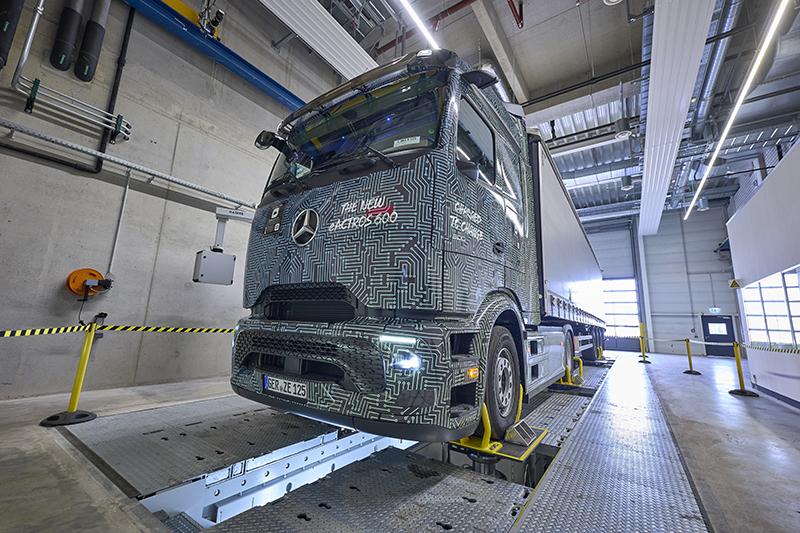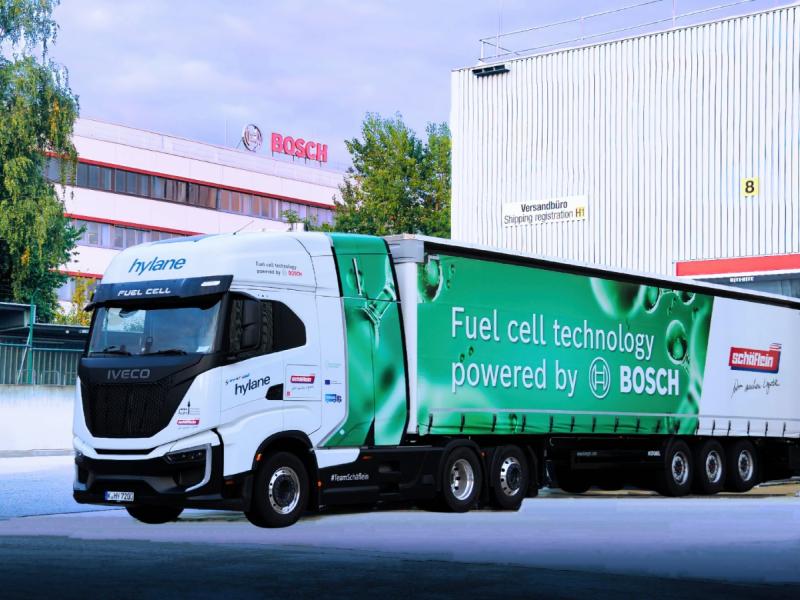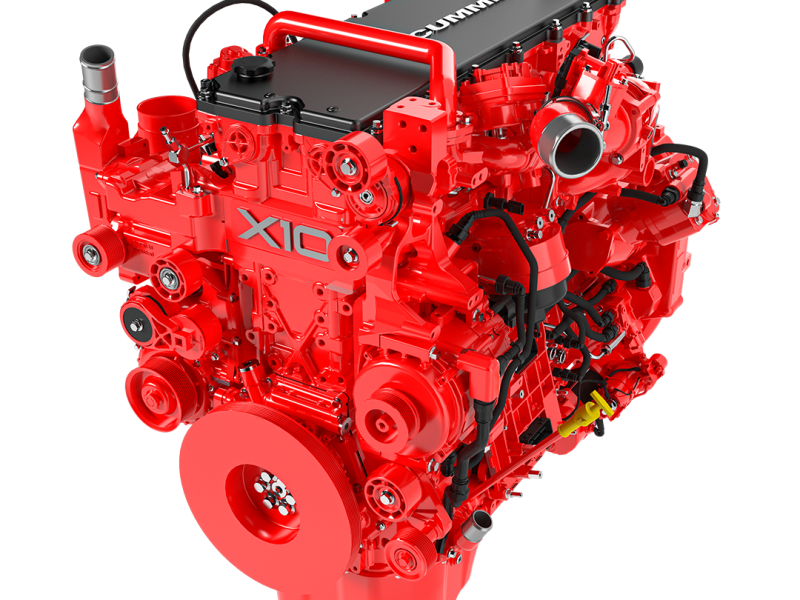Wörth am Rhein is home not only to the largest truck production facility of Mercedes-Benz Trucks but also to the company’s development and testing centre (EVZ). The EVZ makes it possible to concentrate testing with heavy trucks at one location with a total of six innovative indoor test rigs and the running-in track in the directly neighbouring outside area.
At the EVZ, such testing and evaluation processes are part of everyday work – irrespective of the drive type of the vehicles. Activities centre, however, increasingly around specialisation on test procedures relating to battery-electric and hydrogen-based truck drive systems – and these, in turn, are currently focusing on the battery-electric Mercedes‑Benz eActros 600.
Test rig building 220 at the EVZ premises in Wörth houses the Multi Piston Bench, a new development that is probably unique in the world, for analysing the vibration behaviour of vehicles with regard to driver comfort and safety. Another installation at the site is one of Europe’s most powerful Climatic Test Chambers in which testing can be performed at extremely cold and extremely hot temperatures.
Roadway simulation and vehicle behaviour in the Multi Piston Bench
The Multi Piston Bench performs simulations of the vibrations caused by different roadway surfaces. For this purpose, a collection of different roadway surfaces from real life are generated and simulated on the basis of data from actual surveys entered into the system; the simulations range from highway itineraries, rural roads and potholed roadways through to routes consisting completely of poor roads. The generation of vibrations in the vehicle is achieved in a vertical and longitudinal direction using excitation signals with a defined amplitude and frequency.
The developers’ top priority is to use the Multi Piston Bench to obtain validated measuring results and reproducible vibration and resonance analyses of complete vehicles. Irrespective of the drive variant, the vibration and acceleration behaviour of individual vehicle components and assemblies can be examined and assessed. In this context, the behaviour of the chassis and body parts and the effect on traveling comfort is measured and evaluated at differing excitation frequencies. Testing scenarios in the Multi Piston Bench not only include examining the stable installation of bearings and shock absorbers and the effect of their vibration behaviour on other vehicle components but also identifying narrow places where abrasion can occur, such as cable and pipe ducts.
Depending on the scope, the examination of the vibration and resonance behaviour of the complete vehicle or individual assemblies can take between eight and 14 days.
Structure and function of the Multi Piston Bench in Wörth
With its dimensions and its unparalleled testing possibilities, the Multi Piston Bench is unique in terms of its high-performance capabilities. It forms a combination of ten hydraulic cylinders installed longitudinally and ten vertically on an innovative vibration foundation that causes the vehicle clamped in position to vibrate in a targeted manner. One cylinder acting vertically and one longitudinally have been installed for each wheel, and in the case of twin tires, for each pair of wheels.
The vibration foundation bears on a concrete foundation and before each vibration test takes place it is raised using air springs and decoupled from the environment. This prevents the vibrations and oscillations generated during the test procedure from being transmitted to the test rig building. The Multi Piston Bench is driven by a central hydraulic unit consisting of eight pumps with an oil pressure of 280 bars. Each cylinder has a load limit of eight tons.
The cylinders can be controlled individually. This means that the Multi Piston Bench can be used to measure, examine and analyse the vibration behaviour of complete vehicles with up to five axles and a maximum total length of 20 metres. The track width is variable – it can be set to any value between 1.77 metres and 2.06 metres. In this facility, it is possible to test vehicles with semitrailers or trailers with a width of up to 2.50 metres, a maximum height of 5.30 metres, a maximum wheel load of eight tons and a maximum combined weight of up to 60 tons.
Hot and cold: the high-performance Climatic Test Chamber
The high-performance Climatic Test Chamber at the EVZ in Wörth was designed from the outset for use also with electric and hydrogen-powered vehicles. The benefit: In contrast to real-life testing on location, for example in Finland or Spain, the Climatic Test Chamber makes it possible to flexibly reproduce the simulated climate conditions under comparable environmental conditions throughout the year.
The Climatic Test Chamber operates in the temperature range from -40°C to +70°C. In addition to temperature is also has a humidity control that makes it possible to set different humidity levels of up to 100 percent, as required, within the limits of physics. The temperature change coefficient for temperature settings and humidity determinations is 1.0 Kelvin or one degree Celsius per minute; the desired values can be specified with a high level of precision. This means that technical innovations as well as mechanical, electric and comfort functions, such as the air-conditioning, for conventional and alternative drives alike can be tested under climatic conditions ranging from arctic to subtropical.
There is space for two semitrailer tractors in the Climatic Test Chamber. In this chamber, extensive tests are performed on how diverse systems behave under changing temperatures and humidity conditions.
Optimisation of the cold start behaviour of internal-combustion and electric vehicles is an important component in this regard. With e-trucks, the most important aspects of testing are battery management and the battery’s charge (SoC).
The driver’s cab air conditioning is tested in the Climatic Test Chamber, as is the state and the efficiency of the insulation against cold and heat used in the vehicles. In addition, functional testing of mechanical and electric components, such as the steering, tipping cylinders and front hood, is performed under different climatic conditions. Similarly, optional truck equipment specifically for use in Nordic countries undergoes procedures to test proper functioning in arctic cold.
Protection and safety in extreme heat and cold
For test runs, the Climatic Test Chamber is equipped with safety features including an exhaust gas ventilation system and a gas warning system in the event that carbon monoxide, hydrogen or methane escapes. In the event of imminent danger, three stages of optical and acoustic warning systems urge persons present to immediately leave the Climatic Test Chamber. Furthermore, the warning system has a direct link to the works fire service.
Safety measures also include the requirement for the control centre to be staffed during an ongoing test procedure as long as there are persons in the Chamber. Strict access requirements apply and the interior of the Climatic Test Chamber is permanently monitored by cameras: Employees are forbidden to access or remain in the Chamber alone or without protective clothing. There are always two members of staff present, anyone accessing the Chamber at temperatures below -25°C must present a medical certificate. Above +50°C, no member of staff may be inside the Climatic Test Chamber.
Supplementary test procedures: Testing under real-life conditions
The test results obtained in the test facilities under laboratory conditions are compared on an ongoing basis with the results arising from test runs, often of several weeks in duration, on outdoor test roads across Europe, generally under extreme real-life conditions, and are then reviewed on site for reproducibility. The influence of factors such as roadways that are frozen or have softened in the heat, the effect of solar radiation and the light and wind conditions come into play, as they cannot be reproduced under stationary testing conditions. These tests include, for example, test roads in regions like Rovaniemi at the Arctic Circle in Finland, which becomes extremely cold in winter (winter trials) or in the Sierra Nevada in Andalusia, southern Spain, which becomes extremely hot in summer (summer trials). This enables the functions of each individual operating and battery system to be extensively tested, secured and optimised.
Mercedes-Benz Trucks completed summer trials of the battery-electric eActros 600 for long-distance haulage last summer. Test engineers spent around five weeks testing the e-truck with a gross combination weight of 44 tons and a payload of around 22 tons at very high temperatures of up to +44°C in southern Spain. The range of tests extended to proper functioning of the air-conditioning system at great heat, the performance of the e-drivetrain and the battery thermal management through to measurements during charging at rapid charging stations. Following completion of the trials, a prototype furthermore managed to complete under its own power the journey of more than 2000 kilometres from Granada back to Mercedes-Benz Trucks’ development and testing centre in Wörth am Rhein.
In Finland in March 2024, Mercedes-Benz Trucks completed the final winter trials of the Mercedes-Benz eActros 600 truck for long-distance haulage prior to the start of its series production towards the end of 2024. In ice, snow and temperatures down to ‑35 °C, the refined prototype generation of the eActros 600, which is intended for deployment in the important battery-electric transport segment on long international routes, had to prove not only its capabilities in operation but also that its range is suitable for long-distance haulage under extremely adverse conditions. In particular, the effects of extreme cold on handing, ergonomics and comfort were tested at the test location in Rovaniemi. Testing further extended to criteria such as startup behaviour and the protection against cold of the drive components, the thermal management system, the charging behaviour and the robustness of the sensor systems.






